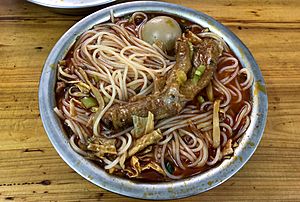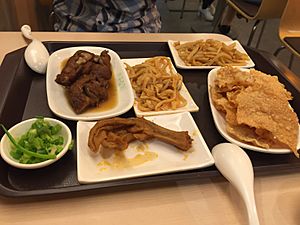Luosifen facts for kids

Luosifen in Liuzhou, its origin
|
|
| Course | Main dishes |
|---|---|
| Place of origin | China |
| Region or state | Liuzhou, Guangxi |
| Main ingredients | Rice vermicelli, stock made from river snails, pickled bamboo shoots, peanuts, tofu skins, chili pepper |
Luosifen (Chinese: 螺螄粉; pinyin: luósīfěn; literally "Snail rice noodle") is a special noodle soup from Liuzhou, a city in Guangxi, China. It's made with rice noodles served in a tasty soup. The soup gets its flavor from river snails and pork bones that are cooked for many hours. Even though it's called "snail noodles," it usually doesn't have snail meat in it!
Instead, Luosifen comes with lots of other yummy toppings. These include pickled bamboo shoots, pickled green beans, shredded wood ear mushrooms, tofu skin, fresh green vegetables, peanuts, and chili oil. You can also add more chili, green onions, or vinegar to make it taste just right for you.
Luosifen is famous for its very strong smell. This smell comes from the pickled bamboo shoots. You can find this dish in small local restaurants and even fancy hotels. In recent years, Luosifen restaurants have opened in big cities like Beijing, Shanghai, and Hong Kong. You can also find them in other countries, like the US. There are even popular instant versions of Luosifen, with millions of packets made every day!
Contents
History of Luosifen
No one is completely sure how Luosifen started. Most people think it first appeared in the late 1970s or early 1980s. There are three popular stories about its beginning.
First Story: Hungry Tourists
One story says that in the 1980s, some hungry tourists arrived in Liuzhou late at night. They found a noodle restaurant that was closing. The owner still decided to serve them. The usual bone soup was gone, so the owner used snail soup instead. He added cooked rice noodles, vegetables, peanuts, and tofu skin. The tourists loved it! This led the owner to improve the recipe, creating the first version of snail noodle soup.
Second Story: A Clerk's Breakfast
Another story from the mid-1980s talks about a dry noodle shop in Liuzhou. A clerk at the shop decided to cook rice noodles with snails for breakfast. People believe an old woman's snail stall was nearby. The lady thought the noodle soup was delicious. So, she started selling it as "snail noodle." Over time, local cooks made the recipe even better, creating the authentic Liuzhou snail noodle soup we know today.
Third Story: Night Market Snack
In the late 1970s and early 1980s, after the Cultural Revolution, local businesses in Liuzhou began to grow again. The workers' cinema was very popular, and a night market grew around it. Someone had the idea to cook river snails and rice noodles together. After a movie, customers accidentally asked a shopkeeper to add oil, water, and snail soup powder to their mix. The recipe was improved over time to please customers. This made snail noodles a famous snack in Liuzhou and even in the Guangxi region.
Recent Growth of Luosifen
Making packaged Luosifen for everyone started in late 2014. This made it a popular food across China. By 2019, packaged Luosifen sales reached 6 billion yuan (a lot of money!). Sales grew even more during the COVID-19 pandemic.
Making Luosifen
Luosifen noodles are a type of rice noodles. They are boiled and then put into a special soup. This soup is made from local river snails and pork bones. The broth cooks for three to ten hours. The snails give the soup a mild, sweet taste. Many herbs and spices are also added to the broth. These include black cardamom, fennel seeds, dried tangerine peel, and star anise.
The noodles themselves are often made from older rice. This gives them a chewier and firmer texture. Many toppings are added for flavor. These include fried dried bean curd sticks, pickled bamboo shoots, black fungus, lettuce, peanuts, and preserved cowpeas. These are the most common ingredients you'll find in restaurants that serve these "smelly" noodles.
What's in the Dish?
The dish usually does not contain snail meat. Instead, it often has other meats or seafood. It also comes with vegetables like cabbage. At restaurants, you can often choose to add pork, beef, chicken, or shrimp. Extra chili oil and pickles can make the dish even better.
Making Luosifen at home can be tricky, and recipes are hard to find. The easiest way to enjoy Luosifen is to eat it at a restaurant. You can also buy prepackaged versions online or at a store. These instant noodles are prepared like instant ramen. You just boil water and add the sauces and vegetables that come in the package.
Luosifen Ingredients
The main ingredients for river snail noodles are sour bamboo shoots, yuba (tofu skin), fungus, peanuts, and dried radishes. Some noodle shops also add sauerkraut or other pickled vegetables. Green vegetables are also an important part of Luosifen. You can also add side dishes like duck feet, tofu, sausage, and marinated eggs.
Luosifen is sometimes jokingly called a "bioweapon" because of its strong, unique smell. But fans of the dish say this smell is what makes the soup so special! The smell comes from the fermented pickled bamboo shoots. Many places and instant noodle makers let you choose if you want this topping or not.
The soup also contains pork bones with spices. These are cooked for about two hours. The main noodles are made from dried Liuzhou rice noodles. These noodles are special because they are made from aged rice. This makes them firm when cooked. They are soaked in cold water before being added to the soup.
Where to Find Luosifen
Luosifen noodles mix flavors from different cultures in China, like Han, Miao, and Dong. It comes from the Guangxi Zhuang region in South China. From there, it's sent to other parts of China, the US, and Canada. When it's sent to other countries, it's usually sold in ready-to-cook packages. Liuzhou is especially famous for Luosifen noodles.
In Vietnam, there's a similar dish called Bún ốc. It's a snail-based noodle dish from Hanoi. It's usually served with fried green banana and fried tofu. Bún ốc is often eaten as a side dish or appetizer. You can find it in small shops, street food stalls, and fancy restaurants. Traditional Luosifen noodles are also sold in Vietnam.
You can find Luosifen in fancy restaurants around the world. Many first opened in Beijing, Shanghai, and Hong Kong. Now, they are also in other countries. There are over five thousand Luosifen restaurants in China, Canada, and the United States. For example, Seattle in the US has Luosifen restaurants. The dish can change a bit depending on where you eat it. Most versions keep the main soup but add different toppings. These can include preserved vegetables, soy products, eggs, pork knuckles, and duck feet.
Luosifen noodles are also becoming popular worldwide through Chinese online stores like Taobao. This website is one of the most visited in the world. It has 5,000 Luosifen noodle shops. They sell about 200,000 noodle packs every day!
See also
 In Spanish: Luosifen para niños
In Spanish: Luosifen para niños





